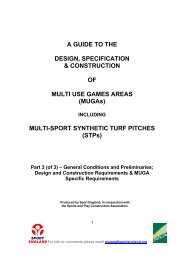View - North East Lincolnshire Council
View - North East Lincolnshire Council
View - North East Lincolnshire Council
You also want an ePaper? Increase the reach of your titles
YUMPU automatically turns print PDFs into web optimized ePapers that Google loves.
BOC Immingham Dissolved Acetylene Project Environmental Statement: Vol. 2 Main Text<br />
6.32 The 100 m distance is indicative of where concerns are most likely to be experienced near to dust<br />
sources from surface mineral operations and in the absence of appropriate mitigation. Research<br />
carried out by BRE Ltd 28 on PM10 from a construction site shows that, if properly mitigated using<br />
best practice techniques, levels may be indistinguishable from background at 150 m from the<br />
source.<br />
Transport Emissions<br />
6.33 Traffic emissions have the potential to influence air quality at sensitive receptors that are located<br />
within 200 m of the edge of a busy road.<br />
6.34 To assess the potential effects on local air quality due to road traffic during operation of the facility,<br />
the HA’s Design Manual for Roads and Bridges (DMRB) 29 Volume 11, Section 3, Part 1, simple<br />
assessment procedure can be applied. The assessment considers existing traffic flows,<br />
proportions of heavy vehicles, road type and alignments in a base year, and the construction year,<br />
without and with the development. If changes in traffic due to the Project are expected to meet the<br />
DMRB assessment criteria for “affected” roads, pollutant concentrations are then estimated at a<br />
number of representative receptors within 200 m and compared with the relevant air quality<br />
criteria (see Table 6.1).<br />
Operation<br />
Process Emissions<br />
6.35 A detailed process description and a discussion of atmospheric emissions that would be<br />
generated from the process are provided in Chapter 3. In summary, the main process emissions<br />
associated with dissolved acetylene production are relatively minor amounts of: acetylene,<br />
acetone, ammonia, phosphine and hydrogen sulphide. These emissions may be released either<br />
continuously or intermittently from point sources (vents) and or area sources (as fugitive<br />
emissions) from the facility.<br />
6.36 An assessment of the process emissions from the acetylene facility was carried out at Scoping<br />
Stage using the EA’s Horizontal Guidance Document H1 Screening Tool. This approach,<br />
described in Annex F of H1, allows the user to determine whether or not a further, more detailed<br />
assessment of emissions to air is required or whether the emissions are negligible and can be<br />
screened out as insignificant.<br />
6.37 The methodology uses conservative dispersion factors appropriate for a range of effective stack<br />
heights, which can be multiplied by a pollutant emission rate to estimate the “process contribution”<br />
(PC) i.e. the maximum ground level pollutant concentration. The PCs can then be compared with<br />
short and long term EALs, and a decision made on whether a further, more detailed assessment<br />
such as dispersion modelling need be undertaken. For the consideration of effects on human<br />
health, the results of the study were compared EALs set out in Annex F of the H1 guidance note.<br />
The results of the Scoping exercise showed that no further assessment would be required for any<br />
of the pollutants considered.<br />
6.38 H1 also requires that an assessment is made of the potential impact of changes in air quality at<br />
ecological conservation sites. Sites need only be considered where they fall within set distances of<br />
the activity:<br />
� SPAs, SACs or Ramsar sites within 10 km of the installation (or 15 km from coal or oil fired<br />
power station); and<br />
� SSSIs, National Nature Reserves (NNRs), Local Nature Reserves (LNRs), LWSs and<br />
ancient woodland within 2 km of the location of the installation.<br />
6.39 Long-term concentrations of ammonia, the only relevant process emission with potential<br />
ecological effects, have been compared with critical level for vegetation contained in H1 guidance.<br />
The results of the ecological assessment are presented in the Impact Assessment Section.<br />
5100935.404 Environmental Statement August 2011 75




